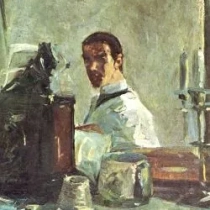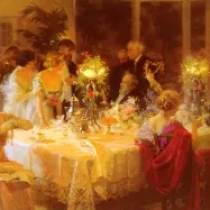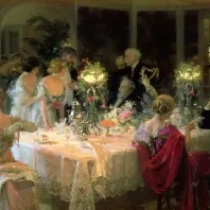 1848 - 1903
post-impressionism
1848 - 1903
post-impressionism
Description Paul Gauguin
Paul Gauguin, born in 1848 in Paris, embarked on a tumultuous artistic odyssey that transcended the boundaries of conventional Impressionism, evolving into the vibrant realm of Post-Impressionism and ultimately shaping the course of Symbolism and Primitivism.
Gauguin's early years were marked by a dual existence: the corporate world and an emerging passion for art. Working as a stockbroker, he frequented the avant-garde circles of Paris, connecting with artists like Camille Pissarro and Claude Monet. However, a seismic shift occurred when financial crises prompted him to abandon the stability of the corporate world for the uncertainty of an artist's life.
Venturing into Brittany, Gauguin's art underwent a transformative phase. His use of bold colors and flattened forms began to diverge from the naturalism of his contemporaries. "Vision after the Sermon," with its cloisonné-like composition, signaled Gauguin's divergence from traditional representation towards a more symbolic and emotionally charged style.
The quest for an unspoiled paradise led Gauguin to Tahiti in 1891, a pivotal juncture in his artistic and personal journey. Immersed in Tahitian culture, he sought authenticity and a return to a primal, uncorrupted state. His works during this period, such as "The Yellow Christ" and "Tahitian Women on the Beach," blended European and indigenous influences, creating a visual language that resonated with a profound sense of exoticism.
Despite the allure of Tahiti, Gauguin faced personal hardships, including health issues and strained relationships. His art became a form of self-expression and escapism, portraying an idealized Polynesian life that often contrasted with the challenges of reality.
Gauguin's artistic legacy is inextricably tied to his relentless pursuit of the primitive and the mystical. His philosophy of "art for art's sake" and rejection of Western conventions influenced artists like Pablo Picasso and Henri Matisse. Gauguin's innovative use of color, bold compositions, and symbolic storytelling set the stage for the modernist movements that followed.
Paul Gauguin passed away in 1903 in the Marquesas Islands, leaving behind a body of work that challenged artistic norms and transcended geographical and cultural boundaries. His journey from the bustling streets of Paris to the idyllic landscapes of Tahiti encapsulates a relentless quest for artistic authenticity and a desire to capture the essence of a world unencumbered by modern complexities. Gauguin's legacy endures as a testament to the transformative power of art and the boundless spirit of exploration.
Gallery
Paintings Paul Gauguin
Quotes
I shut my eyes in order to see.
"I am a great artist, and I know it. It's because of this that I have endured such suffering, but I am a great artist, and I am worth more than you can imagine.
Art is either plagiarism or revolution.
I want to die like a dog, not like a man.
I am what I am, and I am willing to be what I am.







No Comments Yet...